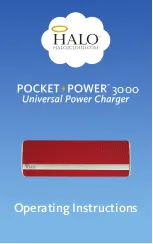
•
4
•
When disconnecting charger, turn switches to off, disconnect AC cord,
6.7
remove clip from vehicle chassis, and then remove clip from battery termi
-
nal.
See OPERATING INSTRUCTIONS for length of charge information.
6.8
FOLLOW THESE STEPS WHEN BATTERY IS OUTSIDE VEHICLE.
7.
A SPARK NEAR THE BATTERY MAY CAUSE BATTERY EXPLOSION.
TO REDUCE RISK OF A SPARK NEAR BATTERY:
Check polarity of battery posts. POSITIVE (POS, P, +) battery post usually
7.1
has a larger diameter than NEGATIVE (NEG, N, –) post.
Attach at least a 24-inch-long 6-gauge (AWG) insulated battery cable to
7.2
NEGATIVE (NEG, N, –) battery post.
Connect POSITIVE (RED) charger clip to POSITIVE (POS, P, +) post of
7.3
battery.
Position yourself and free end of cable as far away from battery as pos-
7.4
sible – then connect NEGATIVE (BLACK) charger clip to free end of cable.
Do not face battery when making final connection.
7.5
When disconnecting charger, always do so in reverse sequence of con
-
7.6
necting procedure and break first connection while as far away from bat
-
tery as practical.
A marine (boat) battery must be removed and charged on shore. To
7.7
charge it onboard requires equipment specially designed for marine use.






































